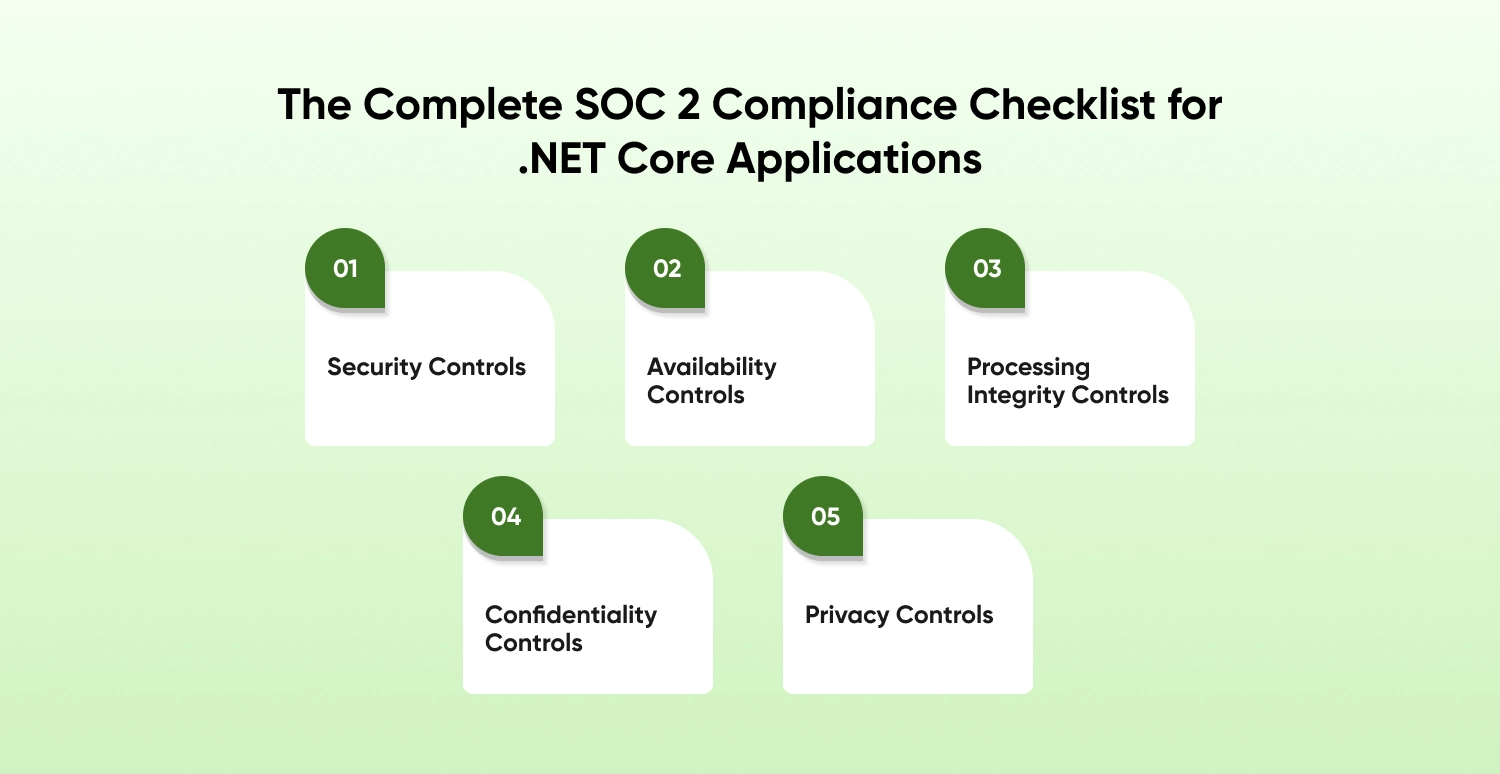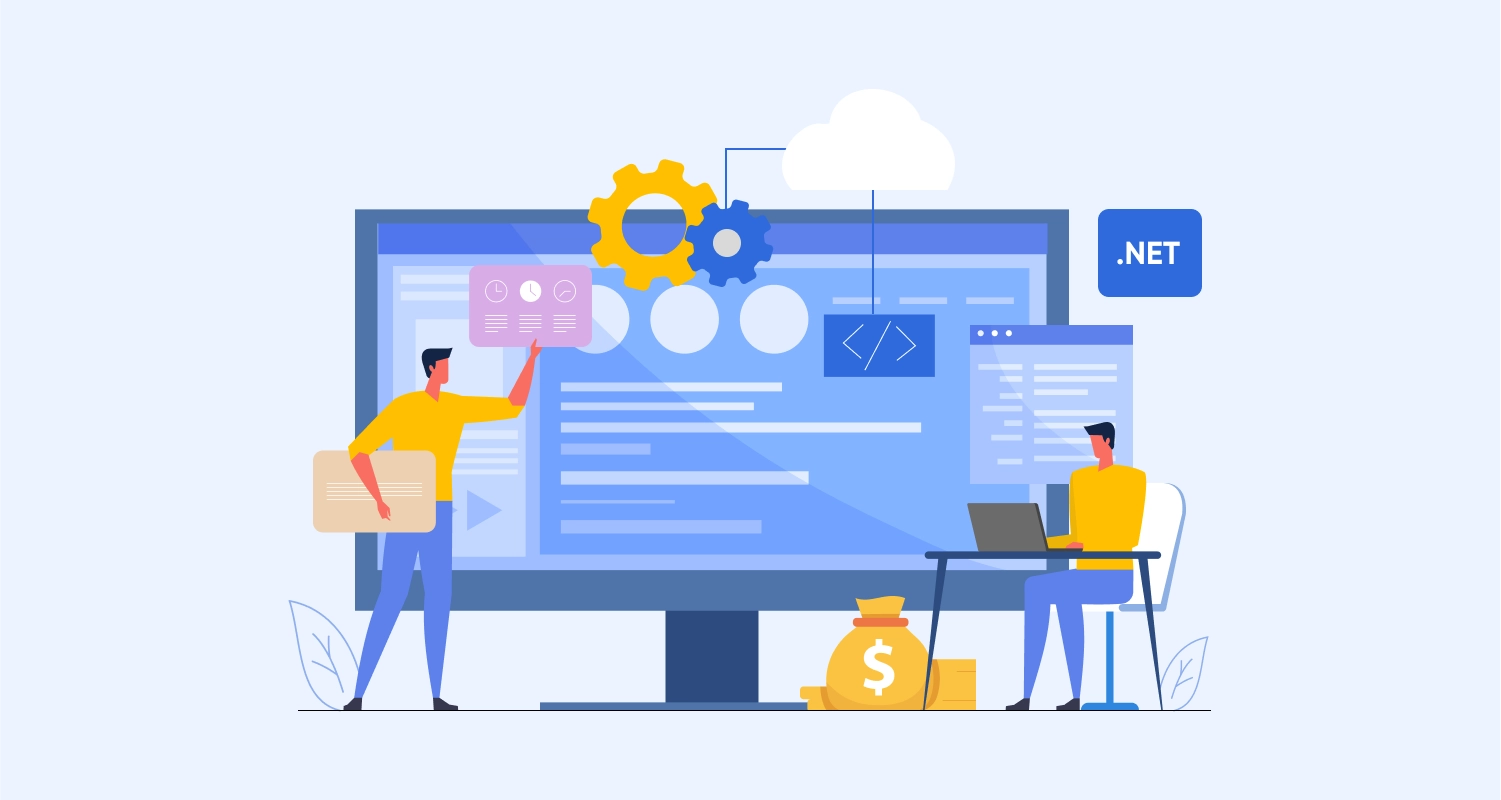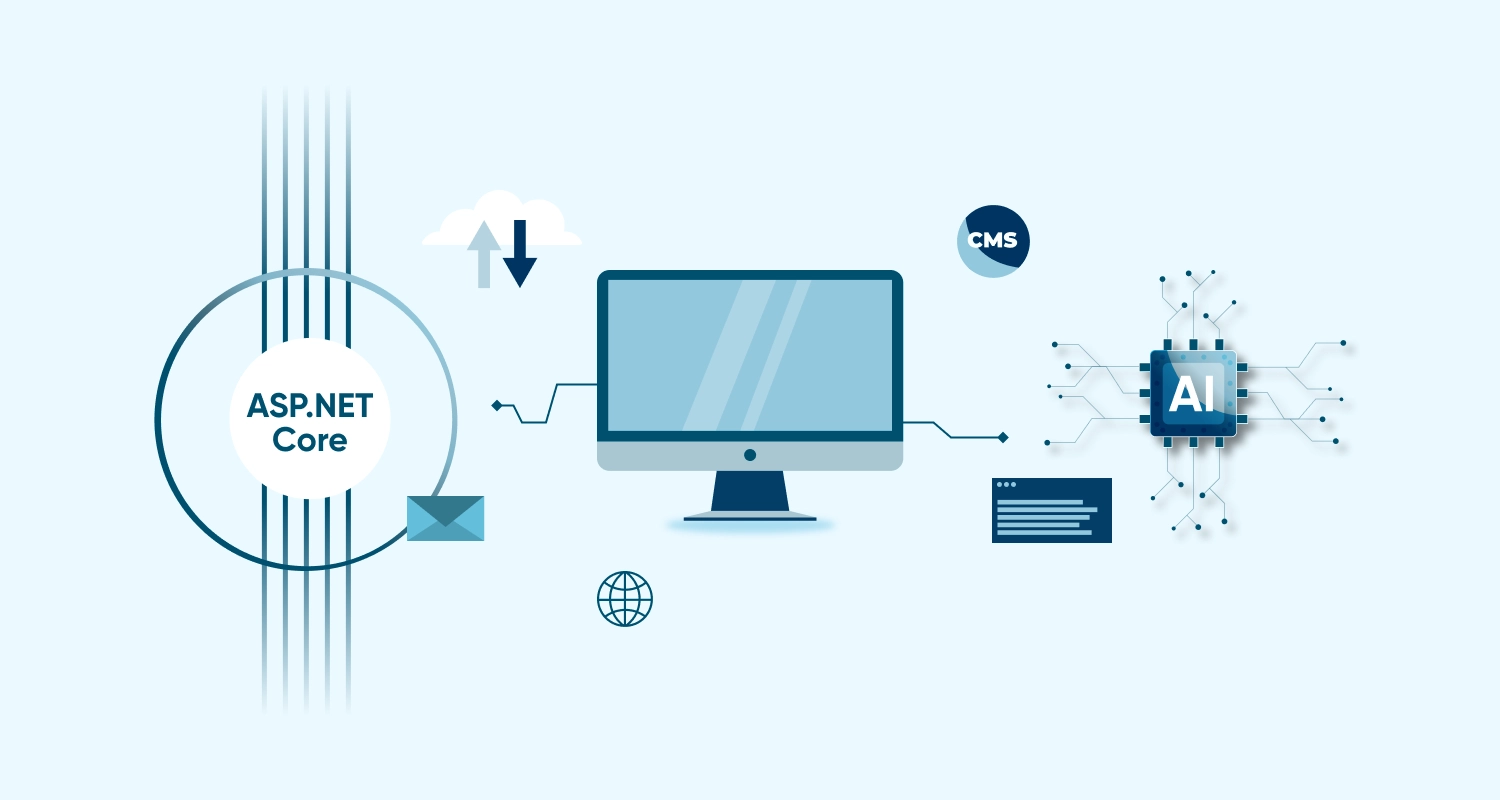Generally clients building MVC projects using .NET Core have a common question – how to ensure it meets industry standards for privacy and data security?
We suggest our clients go for SOC 2 compliance. What is it? It is a complete framework that makes sure your application follows best practices and certain principles that improve system security, availability, processing, privacy and confidentiality.
For this you need a specialized team of ASP.NET Core and MVC framework experts who have experience integrating SOC 2 guidelines in all stages of your software development process. Today, we will discuss the technical best practices, implementation strategies and other important aspects of complete SOC2 compliance requirements.
What is SOC 2 Compliance? The 5 Trust Service Criteria
SOC 2 is an auditing framework initiative by AICPA – the American Institute of CPAs. It evaluates an organization’s controls related to five trust service criteria:
| Trust Principle | Description | Key Considerations for .NET Applications |
| Security | Protection against unauthorized access | Authentication, encryption, vulnerability management |
| Availability | System availability for operation and use | Redundancy, monitoring, incident response |
| Processing Integrity | Accurate, timely, and authorized system processing | Input validation, transaction management, error handling |
| Confidentiality | Protection of confidential information | Access controls, data classification, encryption |
| Privacy | Personal information usage, retention, disposal and more | Consent management, data minimization, user rights |
For apps built with custom ASP.NET Core development services, make sure the developers implement these principles with systematic attention to architecture, coding practices and other operational processes.
Implementing SOC 2 Security Controls in .NET Core Applications
Authentication and Authorization
The base of application security starts with proper identity management. ASP.NET Core provides built-in tools to implement secure authentication and authorization that must be configured correctly to meet SOC 2 security requirements.
Key authentication elements should include:
- Strong password policies with complexity requirements and secure storage
- Multi-factor authentication for sensitive operations
- Secure session management with appropriate timeout settings
- Centralized identity integration
Authorization needs to be done with the principle of least privilege, granting users only minimum required access to carry out their tasks. .NET Core’s policy-based authorization framework enables fine-grained control over application resources.
Secure Development Practices
Organizations leveraging security software development services should integrate security throughout the software development lifecycle by implementing:
- Regular developer training on secure coding practices
- Pre-commit hooks for basic security checks
- Automated scanning during build processes
- Manual security reviews for significant changes
- Penetration testing for critical releases
With these practices, we can rest assured that security is integrated from the start of the development process, and not treated like an afterthought.
Encryption and Data Protection
Encryption helps protect sensitive data against misuse by third-party vendors. ASP.NET Core provides many built-in mechanisms that need to be used properly.
- Follow Transparent Data Encryption for SQL Server databases
- Use column-level encryption for particularly sensitive information
- Secure all communication with HTTPS and proper certificate management
- Get protection against common vulnerabilities with security headers
Availability Controls for SOC 2 Compliance
Health Monitoring and Alerting
Comprehensive monitoring is essential for maintaining high availability. ASP.NET Core’s Health Checks API provides a robust framework for implementing application health monitoring that should include:
- Performance metrics collection (response times, throughput)
- Resource utilization monitoring (CPU, memory, disk)
- Business transaction monitoring
- Error rate tracking
- User experience monitoring
Make sure the alerts are fine-tuned with proper ranges and escalation process to guarantee timely response to any uncertain availability issues.
Disaster Recovery Planning
An effective disaster recovery plan is essential for SOC 2 audit for web applications. This plan should document procedures for:
- Regular backups of databases, file systems, and configuration data
- Scheduled tests of restoration procedures
- Automated or manual failover to redundant systems
- Business continuity procedures during outages
For .NET Core applications deployed in cloud environments, leveraging platform-specific resilience features can enhance availability through services like Azure Traffic Manager, AWS Route 53 Health Checks, or GCP Cloud Load Balancing.

Processing Integrity in .NET Core Applications
Input Validation and Data Quality
Data validation is critical for processing integrity. All input data should be validated against business rules and constraints before processing, including both structural validation and business validation.
ASP.NET Core provides several mechanisms for implementing comprehensive validation that should be consistently applied across the application to prevent data corruption or invalid processing.
Transaction Management
Proper transaction management ensures data modifications are either completed entirely or not at all, maintaining data consistency. This is crucial for financial systems and applications where partial updates could lead to data corruption.
Transaction management in .NET Core applications should address:
- Distributed transactions for operations spanning multiple services
- Idempotent operations designed to be safely retryable
- Compensation logic with rollback mechanisms for failed operations
Error Handling and Logging
Comprehensive error handling and logging are essential for maintaining processing integrity. Applications built with Best Practices for .NET Core development should implement:
- Capture and log all unhanded exceptions using Global exception handling
- Structured logging to capture detailed contextual information
- Transaction tracking with unique identifiers for end-to-end tracing
- Audit logging for all significant data changes and access events
Confidentiality Controls in .NET Core Applications
Access Control Mechanisms
Access control in ASP.NET Core applications should follow the principle of least privilege. Claims-based authorization provides a flexible framework for implementing fine-grained access controls based on user attributes rather than simple role membership.
For sensitive operations, consider implementing additional authorization checks beyond basic role-based controls, such as:
- Time-of-day restrictions
- IP address restrictions
- Device-based restrictions
- Risk-based authentication
- Step-up authentication for high-risk operations
Data Classification and Handling
Effective confidentiality controls require proper data classification and handling procedures:
| Classification Level | Example Data Types | Technical Controls |
| Public | Marketing materials, documentation | No special controls required |
| Internal | Employee directories, project plans | Basic access controls, standard encryption |
| Confidential | Customer data, financial records | Strong encryption, strict access controls, audit logging |
| Restricted | Payment card data, health information | Field-level encryption, MFA for access, enhanced monitoring |
Organizations using SOC 2 compliance software can often automate the monitoring and management of these controls.
Privacy Controls for SOC 2 Compliance
Consent Management
Modern applications must implement comprehensive consent management to comply with privacy regulations and SOC 2 requirements:
- Give clear information about how data is collected and used
- Let users consent selectively to various uses of data
- Maintain auditable records of user consent decisions
- Enable users to review and modify consent choices
Data Minimization and Retention
SOC 2 compliance certification requires implementing data minimization principles:
- Collect only necessary data elements
- Implement automatic data aging and archiving
- Apply defined retention periods to different data type
- Dismiss and dispose the data once it is not needed anymore
SQL Database Compliance for SOC 2
Data Encryption Strategies
Database encryption protects data at rest and in transit. SQL Server provides several encryption options:
- Transparent Data Encryption (TDE) for entire database encryption
- Always Encrypted for column-level protection
- Secure key management processes
- Encrypted backups to prevent data exposure
Access Controls and Least Privilege
SQL Server access should be strictly controlled:
- Create dedicated database accounts with minimal required permissions
- Implement role-based access grouped by job functions
- Conduct periodic audits and reviews of database access rights
Audit Logging for Database Activities
Comprehensive audit logging is essential for detecting unauthorized access:
- Configure SQL Server Audit for comprehensive monitoring
- Implement change tracking for sensitive tables
- Create triggers to log specific data changes
- Capture detailed information about database operations using Extended Events
AI Integration and SOC 2 Compliance
When implementing AI integration in ASP.NET Core applications, additional compliance considerations emerge:
Data Governance for AI Systems
AI systems require robust data governance controls:
- Secure and properly manage AI training datasets
- Maintain records of data sources and transformations
- Securely store and protect trained models
- Restrict access to AI systems and their components
Explainability and Transparency
- Maintain documentation of AI decision processes
- Ensure AI decisions can be explained to users and auditors
- Establish mechanisms for human review of AI decisions
- Regularly test for and mitigate algorithmic bias
The SOC 2 Compliance Journey
Achieving SOC 2 compliance involves several key phases that should be incorporated into any MVC app compliance checklist:
Readiness Assessment and Gap Analysis
- Evaluate existing security policies and procedures
- Compare existing controls to SOC 2 requirements
- Identify missing or inadequate controls
- Prioritize gaps based on risk level
Implementation and Remediation
Organizations that Hire ASP.NET Core Developer talent need to implement missing controls and strengthen existing ones:
- Enhance identity management and access controls
- Implement appropriate data protection measures
- Establish comprehensive logging and monitoring
- Develop and document security processes
Pre-Audit Preparation
- Verify that implemented controls function as intended
- Gather documentation demonstrating control effectiveness
- Address any remaining compliance gaps
- Prepare teams for the audit process
Formal Audit and Ongoing Compliance
After achieving compliance through SOC 2 audit firms, organizations must maintain it through:
- Regular assessment of control effectiveness
- Evaluation of compliance impact from system changes
- Prompt addressing of security incidents
- Periodic compliance assessments
The Complete SOC 2 Compliance Checklist for .NET Core Applications

Here is an overall SOC 2 compliance checklist that covers all important control areas:
Security Controls
- Implement robust authentication mechanisms
- Configure role-based or claims-based authorization
- Enable HTTPS with proper certificate management
- Implement secure password policies
- Configure security headers and CSP
- Implement input validation for all user inputs
Availability Controls
- Implement health check endpoints
- Configure monitoring and alerting
- Establish backup and recovery procedures
- Document incident response processes
- Configure load balancing and scalability
- Create disaster recovery plans
Processing Integrity Controls
- Implement comprehensive input validation
- Configure error handling and logging
- Establish transaction management processes
- Implement data quality checks
- Configure workflow approvals for sensitive operations
- Create data correction procedures
Confidentiality Controls
- Implement data classification
- Configure access controls based on classification
- Add data encryption for data in transit and at rest
- Establish data masking for non-production environments
- Configure database access controls
- Implement secure disposal procedures
Privacy Controls
- Implement privacy notices
- Configure consent management
- Establish data minimization processes
- Implement data retention policies
- Configure cookie compliance
- Establish data subject access request processes
Conclusion
While implementing SOC 2 compliance in .NET Core and MVC applications can be a technically challenging and costly affair, it is important to ensure the app’s security, availability, processing integrity and other pillars. Following these compliances doesn’t only help develop secure apps, but apps that are more reliable and robust.
Whether you want to use the SOC 2 MVC best practices or improve existing apps’ security posture, understanding these SOC 2 guidelines provide a solid foundation for success. Need a team of experts to implement SOC 2 compliance in your .NET Core apps? Hire dedicated ASP.NET Core developers from CMARIX or avail our ASP.NET MVC development services to get the most technical support needed to drive secure and compliant application solutions.
FAQs on SOC 2 Compliance for .NET Core Applications
How fast can I get SOC 2 compliance?
Achieving SOC 2 compliance typically takes 6-12 months for most organizations. For ASP.NET Core applications, the timeline depends on:
– Current security posture
– Scope of compliance
– Application complexity
– Resource availability
– Audit type (Type I vs Type II)
The process generally includes:
1-2 months for gap assessment and planning
3-6 months for control implementation and remediation
2-3 months for evidence collection and pre-audit
1-2 months for the formal audit process
How to make a .NET app SOC 2 compliant?
Making a .NET application SOC 2 compliant involves a systematic approach with particular attention to ASP.NET Core security essentials:
Assessment and Planning
– Evaluate current security controls against SOC 2 requirements
– Identify compliance gaps and prioritize remediation
– Develop a compliance roadmap with specific milestones
Architecture and Design
– Implement secure architectural patterns
– Design with security and availability in mind
– Incorporate privacy by design principles
Authentication and Access Control
– Enhance identity management with ASP.NET Core Identity
– Implement proper authorization mechanisms
– Configure secure session management
Data Protection
– Implement encryption for sensitive data
– Configure secure communication channels
– Establish data classification and handling procedures
Monitoring and Logging
– Implement comprehensive logging
– Configure alerting for security events
– Establish audit trails for sensitive operations
What are the common pitfalls to avoid during SOC 2 compliance for .NET Core apps?
The general limitations or challenges of building SOC 2 compliant .NET Core applications include poor documentation of policies, insufficient logging and monitoring, weak access controls in ASP.NET Core Identity, and insufficient security reviews. Most businesses don’t pay attention to risks of third-party dependencies, leading to unmonitored risks. Addressing these issues at the early stages helps prevent delays while improving audit outcomes.
What are the 5 criteria for SOC 2?
SOC 2 works on five TSC (trust services criteria) such as security, availability, confidentiality, processing integrity and privacy. These can be added in a SOC 2 report, with security being the only mandatory criteria and rest being optional.







